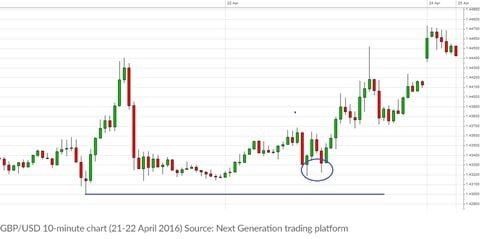Day trading: a definitive guide
As a day trader, you can be your own boss. You can trade from home, from an office or even while travelling – thanks to advances in mobile technology.
But day trading is not for everyone, and there are some things you should be aware of before you start day trading the financial markets. In this guide, we discuss day trading for beginners and some key things to remember.

The rise of the day trader
The idea of day trading has increased in popularity over recent years. Technology has played a big part in this – thanks to fast broadband and mobile connections we have a wealth of real-time market information at our fingertips. This has led to many more people accessing the markets through day trading, in other words, placing trades throughout the day to try and profit from volatility as market prices go up and down.
But what strategies can you use? Should you keep it simple, or use something a bit more complicated?
Day trading strategies
Day trading is a popular short-term trading strategy, which involves the buying and selling of financial instruments, with the aim of closing out of the positions by the end of the day to profit from small movements in price.
Day trading strategies can differ from longer-term trading strategies, in that they focus more on profiting from shorter-term movements in the market, as opposed to moves that take place over a number of days or weeks. Day traders need to be continuously focused, as markets can move suddenly in the short term.
Technical analysis trading
Many day traders use technical analysis and charts and would recommend a 'clean' approach to their trading strategy. These traders prefer not to load their charts with lots of different indicators in order to try and second-guess direction. Rather, they will focus solely on price; this is often referred to as 'price-action trading'. When trading in this way, you still have some key reference points based on what has happened previously, to help you plan future trades.
For some day traders, the previous day’s high and low are important levels to watch when it comes to planning a strategy for that day. This is actually quite logical: yesterday's high marked the point where sentiment changed and the sellers came back into the market, pushing the price lower. The market consensus, therefore, was that the price was too high. And of course, the previous day's low shows where the buyers regained confidence as they felt the market was undervalued – they voted with their wallets and bought. These levels could be important if they come into play again, and can provide the cornerstone of a day trading strategy.
Example day trade: GBP/USD

On the morning of 22 April, the day trader could look at the previous day’s high and low in the popular GBP/USD forex pair. During the previous day, when the price dipped back to the 1.4300 level, the buyers came back in. Of course, there was no way of knowing what would happen on 22 April, but there was a reasonable chance that 1.4300 could end up being an important level for that day's trading. The expectation would be for buyers to step back in again ahead of that 1.4300 mark.
Support and resistance
As can be seen in the chart, this is exactly what happened. There were actually two occasions over the course of a couple of hours where the GBP/USD rate slid back towards that level, trading down to 1.4320. The day trader would consider buying here as there had been demand on the previous day.
Another big advantage of using absolute levels like this to plan trades is the all-important management of risk. Day trading is of course all about trying to make profits, but it's just as important to limit losses when things do not go as planned. If the GBP/USD rate slid below the 1.4300 level then clearly something has changed and the day trade could be exited for a small manageable loss.
Determining your best strategy
No strategy works all the time, but even a simple day trading strategy can help a trader try to pinpoint low-risk, high-reward trades at important points throughout the day. Some traders would also use the failure of one trade as an opportunity to set up another. If the level breaks, it can signal a new trend is starting, presenting another opportunity to try and profit.
Day trading tips
Follow your own rules
Discipline is one of the most important attributes that experienced traders have in common. Keep a watchful eye on your bad habits, and look to resolve them as soon as possible. You are trading in a disciplined way if you decide on a carefully considered set of rules to govern your trading decisions, and then follow them.
Find ways to stop yourself from breaking your rules and look to address it if it is becoming a problem. As a day trader, it's a good idea to re-evaluate your rules at the end of each month, due to the shorter time frame of this style of trading.
Manage your money
Money management is essential when day trading. In fact, it is one of the essential elements of trading over any time frame. Certainly, if you are planning to trade for many years to come, you are going to need to apply successful money management strategies. There are whole books dedicated to this topic, containing many different approaches, and you need to take the time to find a method that you're comfortable with.
The risk-to-reward ratio is important. Remember, it doesn't matter if you win 90% of the time if your losses are much larger than your wins. What's important is that your wins are larger than your losses.
Always use risk management
Never forget to use stop losses to manage your risk when you are placing your orders to enter the market. This is your insurance. You need to be aware of exactly where your stops should be prior to entering the trade. This is a good habit to have and will help protect yourself from trades that go against you.
Standard stop losses can be prone to slippage when price gapping occurs, however, guaranteed stop losses will always close out positions at your chosen level.
The psychology of day trading
Once you have developed an informed opinion – try to act decisively.
Stay level-headed. You should always try to remain calm – this is especially true when you are faced with a loss. Maintain a calm disposition and react in accordance with your rules. Mentally rehearse your worst-case scenarios so that, if they do occur, you are prepared and can keep a level head. Remember that when trading on leverage, your loss can exceed the amount you have deposited on a trade.
Don't let other traders' opinions influence your trading strategy. Sometimes other traders will offer their views on the market and give advice without considering your trading methodology. If you want advice you should consult a qualified professional who will be able to appreciate your style of trading and give their thoughts accordingly, without throwing you off course.
Be patient. Emphasis needs to be placed on the importance of patience when trading. If you can't find any viable trading opportunities, don’t trade for the sake of it. As you get to know a market you may find that knowing when to open or close a trade becomes easier. Your intuition is something that sharpens as you become more experienced as a trader.
Be aware of your stress levels. Day trading can be stressful as it requires constant attention and motivation. You can counter this by taking time to think about your priorities. Get some perspective on trading and its place in your life. Increased stress levels can have a negative impact on your trading decisions so, if you feel like your stress levels are rising, it's probably a good time to step away. You can come back to trading later when you are in the right frame of mind.
Have a flexible approach. When you're trading it's also necessary to be flexible with your positions. Market conditions can change rapidly and so you need to be flexible in your approach. You need to be ready to adapt to changing market conditions, and to alter your trading strategy accordingly.
Stick to your chosen market and a particular timeframe. These are two parameters you can control in an environment that can change very quickly.
Never be afraid of realising your profits. If you find that you have exited a trade at a profit but the trend continues, don't regret your decision. You have made a profit, so start looking for the next opportunity. If you worry that you are frequently exiting too early and are missing out, you could design and test a re-entry technique.
Keep detailed trading records
When you are running a particular trade you could write down your reasons for entering it. This will help you later as you can evaluate your past trades in order to learn from them. By keeping good records and writing down precisely why you entered the trade, you can increase your learning curve.
You also need to have a clear picture of whether you are where you hoped to be for the day, week or month. After you have been day trading for a month, take some time to evaluate what you have done. Look at your trades and ask yourself what you would do differently if you could do the trade again.
This can help you to become a more consistent trader in the long term.
The bottom line
Day trading is a common short-term trading method as it focuses on small movements in price and doesn’t run the risk of any overnight gapping.
Many day traders rely on price charts and technical analysis to form their particular day trading strategy, however, whichever strategy is chosen, they must be able to follow several principles. These include using risk management tools and being able to stay level-headed in spite of the fast-paced and high-risk market environment.
Disclaimer
CMC Markets is an execution-only service provider. The material (whether or not it states any opinions) is for general information purposes only, and does not take into account your personal circumstances or objectives. Nothing in this material is (or should be considered to be) financial, investment or other advice on which reliance should be placed. No opinion given in the material constitutes a recommendation by CMC Markets or the author that any particular investment, security, transaction or investment strategy is suitable for any specific person.
CMC Markets does not endorse or offer opinion on the trading strategies used by the author. Their trading strategies do not guarantee any return and CMC Markets shall not be held responsible for any loss that you may incur, either directly or indirectly, arising from any investment based on any information contained herein.